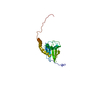Entry Database : PDB / ID : 5xi9Title Solution structure for human HSP70 substrate binding domain Heat shock 70 kDa protein 1A Keywords / / Function / homology Function Domain/homology Component
/ / / / / / / / / / / / / / / / / / / / / / / / / / / / / / / / / / / / / / / / / / / / / / / / / / / / / / / / / / / / / / / / / / / / / / / / / / / / / / / / / / / / / / / / / / / / / / / / / / / / / / / / / / / / / / / / / / / / / / Biological species Homo sapiens (human)Method / Authors Hoshikawa, M. / Tochio, N. / Tate, S. Funding support Organization Grant number Country
Journal : Molecules / Year : 2018Title : Substrate Binding Switches the Conformation at the Lynchpin Site in the Substrate-Binding Domain of Human Hsp70 to Enable Allosteric Interdomain Communication.Authors : Umehara, K. / Hoshikawa, M. / Tochio, N. / Tate, S.I. History Deposition Apr 26, 2017 Deposition site / Processing site Revision 1.0 May 16, 2018 Provider / Type Revision 1.1 Jun 14, 2023 Group / Database references / OtherCategory database_2 / pdbx_database_status ... database_2 / pdbx_database_status / pdbx_nmr_software / pdbx_nmr_spectrometer Item _database_2.pdbx_DOI / _database_2.pdbx_database_accession ... _database_2.pdbx_DOI / _database_2.pdbx_database_accession / _pdbx_database_status.status_code_nmr_data / _pdbx_nmr_software.name / _pdbx_nmr_spectrometer.model Revision 1.2 May 15, 2024 Group / Database references / Category / chem_comp_bond / database_2 / Item
Show all Show less
 Open data
Open data Basic information
Basic information Components
Components Keywords
Keywords Function and homology information
Function and homology information Homo sapiens (human)
Homo sapiens (human) Authors
Authors Japan, 1items
Japan, 1items  Citation
Citation Journal: Molecules / Year: 2018
Journal: Molecules / Year: 2018 Structure visualization
Structure visualization Molmil
Molmil Jmol/JSmol
Jmol/JSmol Downloads & links
Downloads & links Download
Download 5xi9.cif.gz
5xi9.cif.gz PDBx/mmCIF format
PDBx/mmCIF format pdb5xi9.ent.gz
pdb5xi9.ent.gz PDB format
PDB format 5xi9.json.gz
5xi9.json.gz PDBx/mmJSON format
PDBx/mmJSON format Other downloads
Other downloads https://data.pdbj.org/pub/pdb/validation_reports/xi/5xi9
https://data.pdbj.org/pub/pdb/validation_reports/xi/5xi9 ftp://data.pdbj.org/pub/pdb/validation_reports/xi/5xi9
ftp://data.pdbj.org/pub/pdb/validation_reports/xi/5xi9 Links
Links Assembly
Assembly
 Components
Components Homo sapiens (human) / Gene: HSPA1A, HSP72, HSPA1, HSX70 / Production host:
Homo sapiens (human) / Gene: HSPA1A, HSP72, HSPA1, HSX70 / Production host: 
 Sample preparation
Sample preparation Processing
Processing Movie
Movie Controller
Controller










 PDBj
PDBj








 HNCA
HNCA